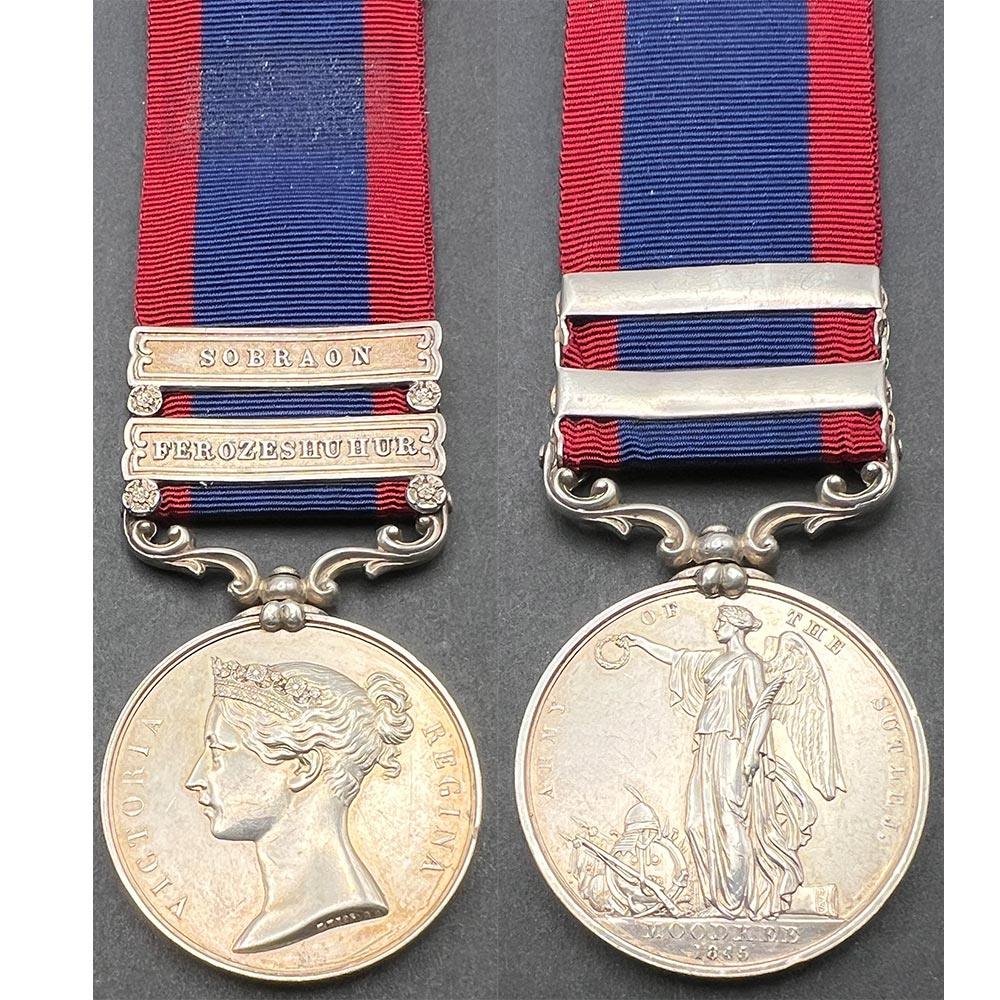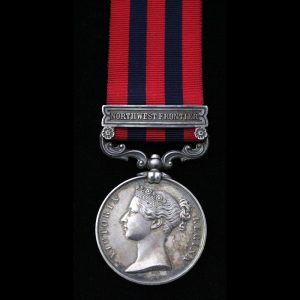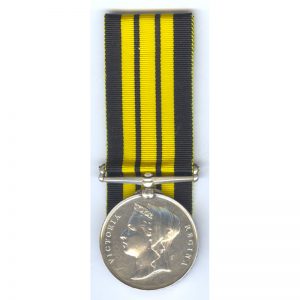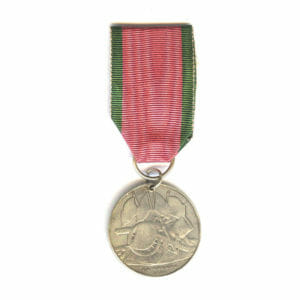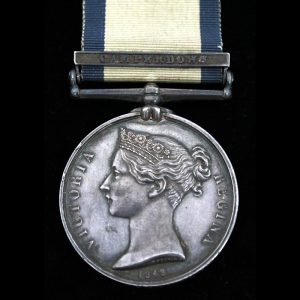Description
Sutlej Medal 1845-6, reverse Moodkee, 2 bars, Forezeshuhur, Sobraon, Private William Green, 80th (Staffordshire Volunteers) Regiment of Foot. Killed in Action at Sobraon on 10th Feb 1846.
Officially impressed: “William Green 80th Regt”
Confirmed on the medal roll, which additionally notes KIA on 10th Feb 1846 and also commemorated on the regimental memorial in Lichfield Cathedral.
William was one of about 58 Soldiers of the 80th Foot to be Killed in Action during the Sutlej War, out of a strength of 821 men.
Provenance: Ex J.B. Hayward and son, 13th August 1973.
Present at all 3 Battles of the Anglo-Sikh War of 1845-1846 that the 80th Foot took part in.
A very rare medal and fatal casualty being Killed in Action at the Battle of Sobraon.
William was born in Buckinghamshire, working as a Labourer prior to enlistment circa 1842.
He first joined the Regiment in New South Wales, Australia on 7th March 1842.
Then would then spend the next 2 years on Army Service around New South Wales.
A muster extract recalls the following postings etc:
Joined the Regiment in Australia on 7th March 1842
April to June 1842, New South Wales
July to September 1842, Sydney, New South Wales, Longbottom
October – December 1842, Sydney NSW, Longbottom, on Guard duty
Jan to March 1843, Sydney NSW, on Guard
April to June 1843, Sydney NSW, on Guard (Port Phillip)
July to September 1843 , Sydney NSW (Port Phillip
October 1843 to August 1844, New Soutbh Wales
September – December 1844, Landed at Calcutta, on 16th November
September to December 1845 – Umballa Agra
January to March 1846, Umballa Agra.
KILLED IN ACTION, 10th February 1846, the date of the penultimate battle of the war, The Battle of Sobraon.
Saw service at the following 3 battles:
Battle of Moodkee
Battle of Ferozeshuhur (Ferozeshah)
The following comes from William Hodson, founder of Hodson’s Horse in a recollection of the battle:
“I lay between them (the 80th) and my Present Regiment, the 1st E.B. Fusiliers on the night of the 21st of December, at Ferozeshah, when Lord Hardinge called out:
‘80th! that gun must be silenced’.
They jumped up, formed into line, and advanced through the black darkness silently and firmly: gradually we lost the sound of their tread, and anxiously listened for the slightest intimation of their progress – all was still for 5 minutes, while they gradually gained the front of the battery whose fire had caused us so much loss. Suddenly we heard a dropping fire – a blaze of the Sikh Cannon followed, then a thrilling cheer from the 80th, accompanied by a rattling and murderous volley as they sprang upon the battery and spiked the monster gun. In a few more minutes they moved back quietly, and law down as before on the cold sand; but they had left 45 of their number and 2 Captains to mark the scene of their exploit by their graves.”
The day of this battle, 21st December 1845, is now celebrated as a Regimental Anniversary, the tradition is carried on by the successor to the regiment, the 3rd Battalion MERCIAN Regiment.
On 20th December 1958, over 100 years after the battle, the 1st Bn South Staffordshire Regiment took part in their Ceremonial Parade as they do each year.
They read the following from their program of the day:
“The parade today is to commemorate the Battle of Ferozeshah fought against the Sikhs in North-West India on December 21st and 22nd, 1845. The 80th Foot, until recently the 2nd Battalion of The South Staffordshire Regiment, reached the battlefield, having covered 150 miles in seven days, and after a heavy day of indecisive fighting, were seeking some well-earned rest in their battle positions. Harassing fire from one particular battery of Sikh artillery which contained one gun of very large calibre was, however, causing the British Force very heavy casualties, and the 80th were ordered to silence it. This they did in a fierce but costly night attack. During their withdrawal, the Sikhs launched a heavy counter-attack, led by a man carrying a large black flag used as a rallying point. The flag was captured, but its retention cost the lives of three officers in succession. Finally, Colour-Sergeant Matthew Kirkland distinguished himself by taking over the flag, and retaining it until the attack was defeated. Later, he was commissioned on the field for his gallantry.
On this day each year, the Colours are handed over to the W.O.s. and Sergeants to mark the occasion, and at midnight they are formally returned to the officers for safe keeping.
The Duke of Wellington, speaking in Parliament some time after the Battle of Ferozeshah, gave high praise to the 80th when he said, “Who but old soldiers could have done what the 80th did at Ferozeshah when they stormed the batteries which were pouring shot and shell into their bivouac.”
The National Army Museum adds the following:
“During the Battle of Ferozeshah, 20-21 December 1845, the 80th Regiment of Foot were tasked with silencing the gun batteries of their Sikh enemies. On the first day they successfully charged the guns through the hail of grape and round shot. However, they suffered severely when they then faced a counterattack from the front which was supported by Sikhs in their rear, who had either hidden in entrenchments or feigned death as the men of the regiment had advanced past them.
That night the regiment undertook a daring, though costly, night attack against a heavy calibre gun that was causing the British forces serious casualties. When fighting resumed the following mourning the regiment was called upon, once more, to assault the Sikh guns. The battle took a heavy toll on the regiment. Four officers and 32 other ranks were killed, four officers and 73 other ranks wounded and seven other ranks were missing in action. Speaking later in Parliament, the Duke of Wellington praised the regiment’s conduct declaring ‘who but old soldiers could have done what the 80th did at Ferozeshah when they stormed the batteries which were pouring shot and shell into their bivouac’.
Further acts of heroism were performed on the afternoon of the second day when the Sikhs launched a series of counterattacks. The regiment engaged a party of the enemy wearing chain armour and bearing a black flag at their head. This standard was seized by Captain Schebberas (A Maltese Officer), who was killed soon after. So too were Captain Best and Corporal Brown, in their efforts to capture this prized battle trophy. Finally, Colour Sergeant Matthew Kirkland took it and, though wounded, managed to retain it until the enemy were beaten off. Kirkland was commissioned as a reward for his gallantry.
This action has been commemorated ever since by the regiment and its successors, down to the present-day Mercian Regiment, in an annual ceremony in which the colours are presented to the Warrant Officers and Sergeants, before being returned to the officers at midnight. The captured Sikh standard now hangs above a Sikh War Memorial in Lichfield Cathedral.”
The Book: A History of the South Staffordshire Regiment (1705-1923) by James P. Jones, provides an account of the regiment’s services in the Sutlej War.
